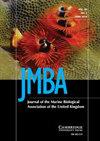温带钙质海绵Grantia sp.对海洋酸化的反应
IF 0.9
4区 生物学
Q3 MARINE & FRESHWATER BIOLOGY
Journal of the Marine Biological Association of the United Kingdom
Pub Date : 2024-05-31
DOI:10.1017/s0025315424000419
引用次数: 0
摘要
海绵是全球海洋系统的重要组成部分,虽然海绵一般都能耐受海洋酸化(OA),但早期的研究大多集中在具有硅质骨架的底栖海绵上。相比之下,人们对具有方解石或文石骨架的钙质海绵在OA条件下的反应知之甚少。在这里,我们测量了新西兰温带钙质海绵格兰蒂亚(Grantia sp.)在模拟 OA 条件下的组织坏死和呼吸速率。我们的处理条件基于 IPCC RCP8.5(pCO2 1131.9 ± 113 μatm)情景,实验时间为 28 天,并将反应与当日对照条件(pCO2 512.59 ± 23 μatm)进行了比较。对照组和处理组海绵的呼吸速率没有明显差异,在实验过程中也没有发现组织坏死的迹象。总之,我们的研究与之前对脱壳海绵的研究一致,表明钙质海绵对 OA 有较强的适应能力。本文章由计算机程序翻译,如有差异,请以英文原文为准。
Responses of the temperate calcareous sponge Grantia sp. to ocean acidification
Sponges are important components of marine systems globally, and while sponges have generally been shown to tolerate ocean acidification (OA), most earlier studies have focused on demosponges with siliceous skeletons. In contrast, little is known of how calcareous sponges, with calcite or aragonite skeletons, may react to OA conditions. Here we measured tissue necrosis and respiration rate of the temperate New Zealand calcareous sponge Grantia sp. to simulated OA. Our treatment conditions were based on the IPCC RCP8.5 (p CO2 1131.9 ± 113 μ atm) scenario over a 28 day experiment, and responses were compared to current day control conditions (p CO2 512.59 ± 23 μ atm). Sponge respiration rate was not significantly different between the control and treatment sponges and there was no evidence of tissue necrosis over the course of the experiment. Overall, our study is consistent with earlier studies on demosponges, showing calcareous sponges to be resilient to OA.
求助全文
通过发布文献求助,成功后即可免费获取论文全文。
去求助
来源期刊
CiteScore
2.30
自引率
8.30%
发文量
68
审稿时长
3-8 weeks
期刊介绍:
JMBA is an international journal, publishing original research on all aspects of marine biology. It includes pioneering work taking place today on major issues concerning marine organisms and their environment. Subjects covered include: ecological surveys and population studies of marine communities; physiology and experimental biology; taxonomy, morphology and life history of marine animals and plants; and chemical and physical oceanographic work. Included with 2010 online subscriptions: Marine Biodiversity Records.

 求助内容:
求助内容: 应助结果提醒方式:
应助结果提醒方式:


